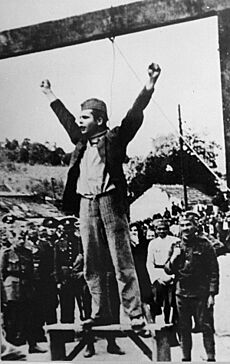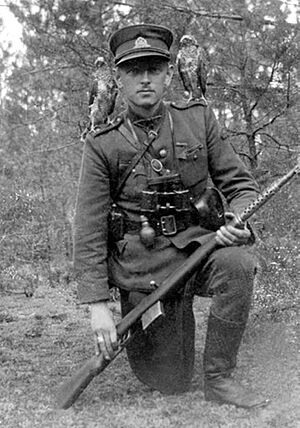Partisan (military) facts for kids
A partisan is a member of a local fighting group. These groups are formed to resist control of an area by a foreign power or an army that has taken over their land. They often use secret or surprise attacks.
The word "partisan" is often used today to describe fighters who resisted during World War II. A famous example is the Yugoslav Partisans led by Josip Broz Tito.
Contents
History of Partisan Fighters
The idea of partisan warfare started a long time ago. It involved local people, or sometimes regular soldiers, fighting behind enemy lines. Their goal was to cause trouble for the enemy. They would cut off communications, capture small towns, ambush supply convoys, and force enemy soldiers to spread out.
One of the first books about partisan tactics was written in the 1700s by a Hungarian officer named De Jeney. Later, during the American Civil War (1861–1865), groups like the "Partisan Rangers" used similar tactics. Leaders like John S. Mosby led these groups. They were more like special forces or rangers than the partisan groups seen later in World War II.
Russian partisans played a big part in defeating Napoleon. Their strong resistance helped force the French army to retreat from Russia in 1812. The Boers in South Africa also used partisan tactics during the Second Boer War (1899–1902). Even Imperial Russia used partisans in World War I.
Partisans Around the World
Partisan groups have fought in many places throughout history. Here are some examples from different regions.
Italian Partisans
The Italian resistance movement fought against German and Fascist forces during World War II. In 1922, Benito Mussolini and his Fascist Blackshirts took control of Italy. Mussolini became a dictator and joined forces with Nazi Germany in 1936.
In July 1943, Mussolini was arrested by his own government. But on September 8, 1943, the Germans invaded Italy and freed Mussolini. They put him in charge of a puppet government called the Italian Social Republic. This led to the Italian resistance movement fighting against both the Germans and Mussolini's forces.
One important fight was the Battle of Piombino in Tuscany. On September 10, 1943, German ships tried to enter the harbor but were stopped by Italian forces.
Italian partisans eventually won their fight. This was helped by the fall of Nazi Germany. On April 25, 1945, a big uprising pushed out the remaining German forces. Mussolini was captured and executed on April 28. German forces in Italy officially surrendered on May 2.
Polish Partisans
The Polish resistance movement in World War II began early in the war. The order to form partisan groups was given on September 16, 1939. The first groups started in Warsaw just two days later.
The largest Polish partisan group was the Armia Krajowa, also known as the Home Army. Many other groups, like the peasant Bataliony Chlopskie and parts of the Polish Socialist Party, joined the Home Army. However, the communist Gwardia Ludowa did not cooperate. Two Jewish groups, the Jewish Military Union and the Jewish Combat Organization, also fought. The Jewish groups led the Ghetto uprising in 1943. The Home Army led the Warsaw Uprising in 1944.
Polish partisans faced many enemies, mainly the Nazi Germans, but also Ukrainian nationalists, Lithuanian Nazi supporters, and even the Soviets. Despite their differences, the Home Army launched a huge sabotage campaign against the Germans. Between 1941 and 1944, they damaged thousands of locomotives, railway cars, and military vehicles. They even sabotaged artillery shells and aircraft engines.
In Ukraine and southeastern Poland, Poles fought against Ukrainian nationalists to protect their people from mass killings. At least 60,000 Poles, mostly civilians, died. Some were Jewish Poles who had escaped from ghettos. Many Polish partisans in Ukraine helped the Soviet Army.
In Lithuania and Belarus, Poles fought against Soviet partisans and Lithuanian Nazi supporters. They won a big victory against the Lithuanian Nazi supporters in the Battle of Murowana Oszmianka.
Hungarian Partisans
Hundreds of Hungarians joined the Slovak National Uprising. Many also fought in other units. Some Hungarian activists fought abroad, like Kilián György in Poland and Szalvai Mihály in Moscow and Yugoslavia. Many were heroes in the French Resistance.
Hungarian anti-fascist groups took over newspapers to spread their message. Their main goal was to break away from the Axis powers. Many of these groups were separate, with several working in Budapest at the same time. One famous group operated in Angyalföld. They forged documents, protected bridges, and took over vehicles and factories.
Ukrainian Partisans
The Ukrainian Insurgent Army (UPA) was a Ukrainian nationalist group that fought during World War II. They fought against the Soviet Union, Czechoslovakia, and Polish groups. The UPA's main goal was to create a united, independent Ukrainian state. They believed that violence was sometimes needed to achieve this.
The UPA mostly fought against Poles and Soviets. They also sometimes fought against the Germans starting in 1943. Later in the war, the UPA sometimes worked with German forces against the Soviets and Poles, hoping to create an independent Ukrainian state. The UPA was involved in the ethnic cleansing of the Polish population in some areas.
Soviet Partisans
Soviet partisans during World War II caused big problems for German troops, especially in Belarus. They made it hard for the Germans to operate. In some areas, Soviet partisans even grew their own food. However, they also sometimes took supplies from local people.
Some reports say that Soviet partisans in Finland attacked villages and civilians. Finnish authorities investigated these war crimes, but Russia did not allow access to Soviet records. In East Karelia, most partisans attacked military targets. But inside Finland, nearly two-thirds of their attacks were on civilians, killing many people.
Yugoslav Partisans
The Yugoslav Partisans were Europe's most effective anti-Nazi resistance movement. They were led by the Communist Party of Yugoslavia and their commander, Marshal Josip Broz Tito. They played a major role in freeing their country during World War II.
By mid-1943, partisan resistance had grown into a major problem for the Germans. They suffered heavy losses in Yugoslavia. By late 1944, the Partisans had 650,000 men and women organized into armies and divisions. By April 1945, they numbered over 800,000.
Near the end of the war, in March 1945, the resistance forces became the regular Yugoslav Army. Yugoslavia was one of only two European countries largely freed by its own forces during World War II. They received some help from the Soviet Union and the British, but mostly fought on their own. Because of this, Yugoslavia was somewhat independent from both major powers after the war.
Lithuanian Partisans
In Lithuania, resistance against Soviet rule was very strong. Guerrilla groups controlled large parts of the countryside until 1949. When they weren't fighting the Soviet army, they slowed down Soviet control through ambushes, sabotage, and killing Communist officials. They also freed imprisoned fighters and printed secret newspapers.
On July 1, 1944, the Lithuanian Liberty Army (LLA) declared war on the Soviet Union. They ordered their members to form fighting groups in the forests. The LLA had 10,000 members by mid-1944. Many LLA leaders were killed or arrested by the Soviets.
The Supreme Committee for the Liberation of Lithuania (VLIK) was formed in 1943. VLIK published underground newspapers and encouraged resistance against the Nazis. After the Soviets took over Lithuania again, VLIK moved west. They worked to make sure the world knew that Lithuania was occupied and shared information from behind the Iron Curtain.
Former soldiers, farmers, teachers, and even students joined the Lithuanian partisan movement. Society and the Catholic church strongly supported them. It's thought that by the end of 1945, 30,000 armed people were hiding in the forests.
The partisans were well-armed. They often got weapons by fighting Soviet secret police or buying ammunition from Red Army soldiers. Captured Lithuanian "Forest Brothers" (partisans) were often tortured or killed. Their families were sent away to Siberia.
Juozas Lukša was a partisan who escaped to the West and wrote a book about his experiences. He was killed after returning to Lithuania in 1951. Pranas Končius was the last Lithuanian anti-Soviet fighter, killed in 1965. He was honored as a hero in 2000.
South Korean Partisans
There were also Communist partisans in the Korean War who fought during that conflict.
Notable Partisan Groups and Battles
- Albanian Partisans
- Afghan Mujahideen
- Armenian irregular units
- Armia Krajowa
- Armia Ludowa
- Bataliony Chłopskie
- 2022–2023 Belarusian and Russian partisan movement
- Bulgarian resistance movement during World War II
- Bushwhackers
- Caucasian Front (Chechen War)
- Cursed soldiers
- Czechoslovak resistance
- Danish resistance movement
- Dutch Resistance
- FARC (Revolutionary Armed Forces of Colombia)
- Forest Brothers
- Francs-Tireurs et Partisans
- Free France
- French Resistance
- Greek Resistance
- Green Guard
- Italian resistance movement
- Irish Republican Brotherhood
- Jewish partisans
- Jewish Combat Organization
- Kuperjanov Infantry Battalion
- Kurdish Partisans
- Kuva-yi Milliye
- Lithuanian partisans
- Mosby's Rangers
- National Armed Forces
- Norwegian resistance movement
- Operation Anthropoid
- Partisans Armés, a faction of the resistance in German-occupied Belgium in World War II.
- Partisan Ranger Act
- Peace Companies
- Pomeranian Griffin
- Polish resistance movement in World War II
- Romanian anti-communist resistance movement
- Slovak National Uprising
- Soviet partisans
- Spanish Maquis
- Tibetan Defenders of the Faith Volunteer Army
- Ukrainian Insurgent Army
- Ukrainian resistance during the Russian invasion of Ukraine
- Viet Cong
- Yugoslav Partisans
- Russian Liberation Movement
See also
 In Spanish: Guerra de guerrillas para niños
In Spanish: Guerra de guerrillas para niños
- Asymmetric warfare
- Fifth column
- Guerilla warfare
- Improvised explosive device
- List of guerrillas
- Unconventional warfare




